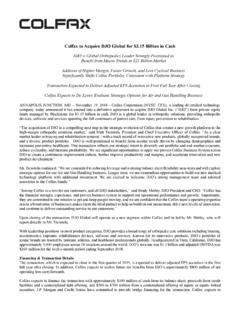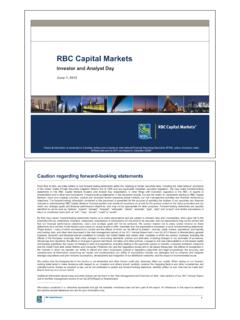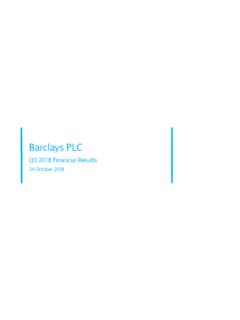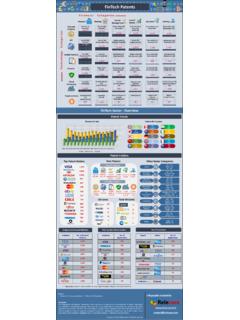Transcription of The Leverage Ratio - World Bank
1 NOTE NUMBER 11. PUBLIC POLICY FOR THE PRIVATE SECTOR. DECEMBER 2009. The Leverage Ratio FINANCIAL AND PRIVATE SECTOR DEVELOPMENT VICE PRESIDENCY. Katia D'Hulster A New Binding Limit on Banks Katia D'Hulster E xce ssive le ver a g e b y b a nk s is wid e ly b e lie v e d t o ha v e c o n t r i b u t e d t o (kdhulster@worldbank .org) is a senior financial the glob al f ina nc ia l c r is is . T o a d d r e s s t his , t he int e r na t io n a l sector specialist in the community ha s p r o p o s e d t he a d o p t io n o f a no n- r is k - b a s e d c a p i t a l Financial Systems measure , the l e v e r a g e r a t io , a s a n a d d it io na l p r ud e nt ia l t oo l t o Department of the World Bank. comp le me nt minim um c a p it a l a d e q ua c y r e q uir e m e nt s . I t s a d o p t i o n can re d uce the r is k o f e x c e s s iv e le v e r a g e b uild ing up in in d i v i d u a l This is the 11th in a series of policy briefs on entities and in t he f ina nc ia l s y s t e m a s a who le.
2 T he le v e r a g e r a t i o the crisis assessing the has inhe rent lim it a t io ns , ho we v e r , a nd s ho uld t he r e f o r e b e c o n s i d e r e d policy responses, shedding light on financial reforms as just one of a s e t o f m a c r o - a nd m ic r o - p r ud e nt ia l p o lic y t o o l s . currently under debate, Excessive Leverage by banks is widely believed assets exceed its equity base, its balance sheet is and providing insights to have contributed to the global financial crisis said to be leveraged. Banks typically engage in for emerging-market policy (FSB 2009; FSA 2009). As a result, the G-20 and Leverage by borrowing to acquire more assets, with makers. the Financial Stability Board have proposed the the aim of increasing their return on equity. introduction of a Leverage Ratio to supplement Banks face economic Leverage when they are risk-based measures of regulatory exposed to a change in the value of a position by more than the amount they paid for it.
3 A. What is Leverage ? typical example is a loan guarantee that does Leverage allows a financial institution to increase not show up on the bank's balance sheet even THE World BANK GROUP. the potential gains or losses on a position or though it involves a contingent commitment that investment beyond what would be possible may materialize in the future. through a direct investment of its own funds. Embedded Leverage refers to a position with There are three types of Leverage balance sheet, an exposure larger than the underlying mar- economic, and embedded and no single mea- ket factor, such as when an institution holds a sure can capture all three dimensions simulta- security or exposure that is itself leveraged. A. neously. The first definition is based on balance simple example is a minority investment held by sheet concepts, the second on market-dependent a bank in an equity fund that is itself funded by future cash flows, and the third on market risk. loans. Embedded Leverage is extremely difficult Balance sheet Leverage is the most visible and to measure, whether in an individual institu- widely recognized form.
4 Whenever an entity's tion or in the financial system. Most structured THE Leverage Ratio A NEW BINDING LIMIT ON BANKS. credit products have high levels of embedded As with regulatory capital measures, the Leverage , resulting in an overall exposure to loss Leverage Ratio generally applies at the level of that is a multiple of a direct investment in the the individual bank as well as on a consolidated underlying portfolio. Two-layer securitizations or basis. How the Ratio is actually calculated and resecuritizations, such as in the case of a collater- monitored will therefore usually be aligned with alized debt obligation that invests in asset-backed the scope of prudential consolidation practiced securities, can boost embedded Leverage to even in a jurisdiction. higher Who uses a Leverage Ratio ? 2. Measures of Leverage Three countries with large international banking The most widely used measure of Leverage for reg- systems are either using a Leverage Ratio or have ulatory purposes is the Leverage Ratio .
5 Leverage announced plans to do so. The United States and can also be expressed as a Leverage multiple, which Canada have maintained a Leverage Ratio alongside is simply the inverse of the Leverage Ratio . risk-based capital adequacy requirements, while The Leverage Ratio is generally expressed as Switzerland has announced the introduction of a Tier 1 capital as a proportion of total adjusted Leverage Ratio that will become effective in 2013. assets. Tier 1 capital is broadly defined as the sum Other countries will probably also adopt this tool. of capital and reserves minus some intangible These countries may use a Leverage Ratio for both assets such as goodwill, software expenses, and micro- and macro-prudential purposes for exam- deferred tax In calculating the Leverage ple, as a maximum Leverage limit for supervised Ratio , these intangibles have to be removed from entities, an indicator for monitoring vulnerability, the total asset base as well, to make it comparable or a trigger for increased surveillance or capital to Tier 1 capital (figure 1).
6 Requirements under Pillar 2 of the Basel II capital The Leverage Ratio can thus be thought of accord. as a measure of balance sheet or, to the extent Among the three countries, the United States that it also includes off-balance-sheet exposures has the simplest Leverage Ratio , expressed as a (Breuer 2000), economic Leverage . As a result minimum Ratio of Tier 1 capital to total average of differences in accounting regimes, balance adjusted assets (defined as the quarterly average sheet presentation, and domestic regulatory total assets less deductions that include goodwill, adjustments, however, the measurement of lever- investments deducted from Tier 1 capital, and age ratios varies across jurisdictions and banks. deferred taxes). The Leverage Ratio is set at 3. Accounting regimes lead to the largest variations. percent for banks rated strong (those that pres- In particular, the use of International Financial ent no supervisory, operational, and managerial Reporting Standards results in significantly weaknesses and are therefore rated highly under higher total asset amounts, and therefore lower the supervisory rating system) and at 4 percent Leverage ratios for similar exposures, than does for all other banks.
7 Banks' actual Leverage ratios the use of generally accepted accounting are typically higher than the minimum, however, principles. The reason is that under International because banks are also subject to prompt correc- Financial Reporting Standards netting conditions tive action rules requiring them to maintain a are much stricter and the gross replacement value minimum Leverage Ratio of 5 percent in order to of derivatives is therefore generally shown on be considered well capitalized. The Leverage the balance sheet, even when positions are held Ratio applies on a consolidated basis (at the level under master netting agreements with the same of the bank holding company) as well as at the counterparty. level of individual banks, but it does not take into account off-balance-sheet exposures. A higher Figure How the Leverage Ratio is calculated Ratio may be required for any institution if war- ranted by its risk profile or circumstances. 1 Equity Reserves Intangible assets Tier 1 capital Total assets Intangible assets Adjusted assets Tier 1 capital/Adjusted assets Leverage Ratio The larger investment bank holding com- panies and their subsidiaries were regulated by the Securities and Exchange Commission and thus were not subject to a Leverage Instead, there Note: Intangible assets include goodwill, software expenses, and deferred tax assets.
8 Were restrictions at the level of the individual firm on the amount of customer receivables the invest- age Ratio , with an expansive definition of assets ment bank could hold as a multiple of capital (net and a conservative definition of capital, as a capital rule). Only two of the five investment bank supplementary binding measure to the Basel II. holding companies originally affected by this rule risk-based framework (BCBS 2009). still exist (Goldman Sachs and Morgan Stanley), however, and they have now been converted into Benefits of the Leverage Ratio bank holding companies. Introducing the Leverage Ratio as an additional The Canadian assets to capital multiple is a prudential tool has several potential benefits. more comprehensive Leverage Ratio because it also measures economic Leverage to some extent. It is A countercyclical measure applied at the level of the consolidated banking The financial crisis has illustrated the disrup- group by dividing an institution's total adjusted tive effects of procyclicality (amplification of the consolidated assets including some off-balance- effects of the business cycle) and of the risk that sheet items5 by its consolidated (Tier 1 and 2) can build up when financial firms acting in an capital.
9 Under this requirement total adjusted individually prudent manner collectively create assets should be no greater than 20 times capi- systemic problems. There is now broad consen- tal, although a lower multiple can be imposed sus that micro-prudential regulation needs to be for individual banks by the Canadian supervi- complemented by macro-prudential regulation sory agency, the Office of the Superintendent that smooths the effects of the credit cycle (FSA. of Financial Institutions (OSFI). This is more 2009; Andritzky and others 2009). This has led conservative than the Leverage Ratio and to proposals for countercyclical capital require- the inclusion of off-balance-sheet items strength- ments and loan loss provisions that would be ens the Ratio even more. Indeed, the stringency higher in good times and lower in bad times. of Canada's Leverage Ratio has been cited as one The Leverage Ratio is versatile enough to factor along with sound supervision and regu- be used both as a macro- or micro-prudential lation, good cooperation between regulatory policy tool and as a countercyclical instrument.
10 Agencies, strict capital requirements, and con- Intuitively, one would expect that in a fair-value servative lending practices contributing to the environment a rise in asset prices would boost strong performance of its financial sector during bank equity or net worth as a percentage of total the financial crisis (IMF 2009). assets. Stronger balance sheets would result in a In 2008 the Swiss regulator FINMA, in strength- lower Leverage multiple. Conversely, in a down- ening capital adequacy requirements, introduced turn, asset prices and the net worth of the institu- a minimum Leverage Ratio under Pillar 2 of Basel II tion would fall and the Leverage multiple would solely for Credit Suisse and UBS. The Swiss lever- be likely to increase (table 1). age Ratio is based on Tier 1 capital as a proportion Contrary to intuition, however, empirical evi- of total adjusted assets and is set at a minimum of dence has shown that bank Leverage rises during 3 percent at the consolidated level and 4 percent boom times and falls during downturns.














